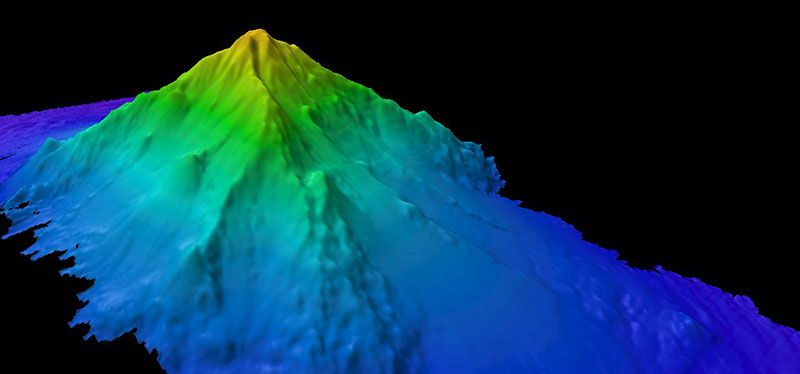

A previously unmapped seamount we are calling "Kahalewai." This seamount has four ridges that radiate outward from the center. This ~4,200-meter (~13,800-foot) high seamount was almost 1,000 meters taller than previously thought. Image courtesy of the NOAA Office of Ocean Exploration and Research, Mountains in the Deep: Exploring the Central Pacific Basin. Download larger version (jpg, 245 KB).
The abyssal plains cover ~70 percent of the global seabed and are the biggest habitat on Earth’s surface. These plains stretch for many thousands of kilometers across ocean basins, beginning at the base of continental margins and extending to the most remote parts of the ocean.
Despite their name, abyssal plains are not solely flat, but are punctuated by hills and seamounts. Abyssal hills rise up to 1,000 meters (3,280 feet) above the seafloor, and seamounts are taller still. These topographic features alter currents and near-bed flows, causing the winnowing of sediment and enhanced deposition of organic matter (food for deep-sea animals). The seafloor environment at abyssal hills and seamounts is more heterogeneous than abyssal plains, ranging from soft sediments to exposed rocks.
Diversity and abundance of animals are linked to environmental differences between different abyssal habitat types.. The animal communities living on seamounts and abyssal hills are diverse and different from those on the nearby abyssal plains. While some organisms live in both places, there are many animals that appear to occur only on seamounts and abyssal hills. In general, more suspension feeders, such as corals, live on hills and seamounts than on the adjacent plain. In other regions, overall biomass has been found to be higher on seamounts and abyssal hills than on the plain.

Dr. Adrian Glover inspects animals using a microscope while at sea. Image courtesy of the NOAA Office of Ocean Exploration and Research, DeepCCZ expedition. Download larger version (jpg, 374 KB).
So, studying abyssal hills and seamounts in addition to the flat parts of the abyssal plains will give a better picture of the full range of habitats and animal communities in an abyssal region.
The seabed on seamounts will likely not be mined for polymetallic nodules because their slopes are too steep for mining vehicles. However, the life and habitats on seamounts could be impacted indirectly by mining, through the plumes (clouds) of sediment that may be disturbed by mining activities on the plain nearby. Some in the deep-sea mining industry have also speculated that seamounts could be refuges for animals during mining activities. These possibilities provide more reasons to us to study seamounts and the habitats and fauna found there.